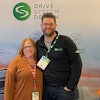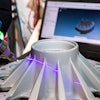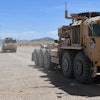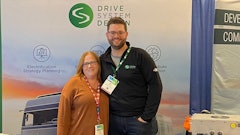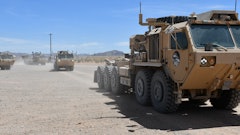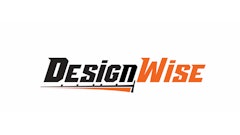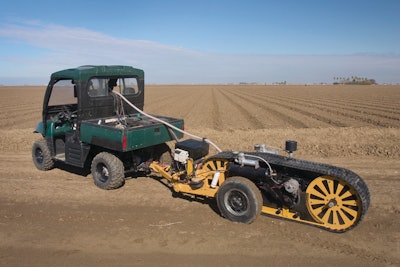
Sometimes the key to a project's successful completion is not in slugging it out in-house but in asking for help.
Jim Burton, president and chairman, AgRobotics LLC, Little Rock, AR, saw precision farming methods change agriculture in the 1990s, and he thought better soil sampling methods would enhance the process. Later that decade Burton was semi-retired from 35 years of farming and started working on what would become the AutoProbe. Burton built and tested two proof-of-concept prototypes, but he wanted to enlist a team of engineers to carry the concept to the production stage.
Like many of agriculture's significant advances in machinery design, the AutoProbe is the brain-child of a farmer who knew there had to be a better way. Talking to potential customers and media-types at this year's World Ag Expo, Tulare, CA, Burton admitted independent engineering firms can bring a wealth of experience to the table on the very first meeting. For the inventor or the established manufacturer, there's no delay between concept and completion due to the time required to find and train good help.
"I love creating and building, and have always been a hands-on sort of guy," says Burton. Impressed with Diedrichs & Associates Inc.'s portfolio of agricultural equipment, he called founder Bob Diedrichs. "From the first day, that firm brought hundreds of years worth of engineering experience to the project, aided by advanced modeling programs used by major equipment manufacturers."
Burton relocated to Iowa, where he had a desk at Diedrich's Cedar Falls office for more than a year. Burton's concept was brought to virtual life with Diedrich's 3D modeling software, then a prototype machine was built in Cedar Falls. Today the prototype continues its national tour while back in Cedar Falls the design is tweaked and more machines are produced.
A high-speed, on-the-go tool for precision soil sampling, the AutoProbe is designed to be an important step in precision agriculture. Users do not have to walk the field to gather soil samples; AutoProbe does it quickly and accurately.
In its current form, the AutoProbe is pulled by a light utility vehicle that is guided and steered with GPS. Soil samples are collected by the AutoProbe at a precise depth and exact intervals over a section of land. On a 2.5 acre grid and at 8 mph, 20 cores can be pulled to constitute a 1-lb. sample. Soil samples are bagged and tagged in the cab of the vehicle. AutoProbe allows for consistent, repeatable results over a variety of terrain and soil conditions.
People come to us for "problem solving," says Diedrichs. "We help them get the work done whether it's because they don't have the time, the technical expertise, or the resources to do it. We will improve an existing machine or look for ways to save production costs, and we can carry it all the way to the prototype stage."
Bob Diedrichs loves a good challenge, and since 1982 his firm has tackled plenty. Because his shop is located in the heart of corn and soybean country, you'd expect that his staff would see a fair share of farm equipment. While Diedrichs works with some of the most recognizable names in the farm machinery business, the strength such a design firm can bring to an OEM's engineering staff comes from the variety of projects it has completed.
For Diedrichs, the portfolio includes golf ball dispensers, industrial snow blowers and a machine that resembles a seed drill used for injecting liquid polymer into established turf (the polymer can retain up to 400 times its weight in water, acting like a reservoir in the soil). Diedrichs has also been hired to develop and produce production and test equipment.
This range of experience can be valuable to an in-house engineering department. "We bring a lot of experience from a wide range of seemingly unrelated industries," says Scott Micoley, manager of program development, Brooks Stevens Design Associates, Allenton, WI. "We've found that engineers can be focused on their particular industry and may not be exposed to different methodologies, materials, and manufacturing methods. We can look at a problem more objectively, with a fresh perspective. We can ask the stupid questions and get them to admit, 'I don't know why we've never done it that way.'"
Founded by Brooks Stevens, a pioneer and celebrity in the world of industrial design, Brooks Stevens Design will celebrate 75 years in 2009. During that time the multi-disciplinary design firm has worked behind the curtain to develop the proper look and feel for a very large array of consumer and industrial goods, ranging from motorcycles to power tools. While you may not have a Brooks Stevens-designed Oscar Mayer Wienermobile in the garage, the probability that you do own several other products in Brooks Stevens Design's portfolio is high.
"An OEM might have the staff in-house, but they'll find their workload exceeds the resources they have available. We will get the spill-off work," says Scott Moeller, vice president, business development, Brooks Stevens Design. "We might get a call at the 11th hour, asking us to help them finish a project. We are brought in as an extension of the staff. Then, when the project is done, we go away. We don't stay on the payroll."
At other times, Brooks Stevens Design, which has nearly 70 employees, will be hired during the early stages of a development project to help differentiate a product from its competition. "We'll bring a fresh perspective to the program" says Moeller. "That is something project managers either understand, or they don't. The managers who bring us in realize the perspective a company like Brooks Stevens brings to the table can help them come up with new concepts right out of the box."
Creating an item in a paperless environment allows design changes to be made quickly. As the piece moves along Brooks Stevens Design can build a prototype from a variety of materials and methods (such as CNC, fabricating and rotomolding) and paint it in the OEM's colors so decision makers can get a tactile model.
An independent firm may employ development tools an in-house engineering staff might not be accustomed to using. "We'll go beyond setting up focus groups at corporate headquarters. We have a team dedicated to interviewing the users," says Moeller. "Brooks Stevens employed ethnography-based research on a recent crane cab project, looking at what the operators do in the field, and how they use the machinery. "The users of these products are the true experts, but oftentimes what they'll write in a questionnaire is different from what they do every day out of habit. Videotaping a work day gave us a lot of answers."
Running out of time?
"When a customer has a problem and needs a quick reaction, they can pull on our resources and experience working on other vehicles to develop a solution," says Chris Coxon, director of engineering, GS Engineering (GSE), Houghton, MI. GSE provides engineering design, prototype development and testing for military and private sector clients.
There is a close relationship to the conditions military and off-road vehicles work in. The military experience has helped give GSE expertise in the finite element analysis (FEA) department. "Military vehicles are subjected to tremendous G loads during air drops or while being transported by rail. FEA testing helps us prove that the structure will hold up under real-world conditions." When it comes to material selection, two metallurgists are on staff to lend their expertise.
GSE was founded in 2001 by Glen Simula, who worked for Michigan Tech's Keweenaw Research Center for 19 years. GSE has enjoyed rapid growth; today there are 39 full-time employees in Houghton as well as satellite offices near Detroit and Washington, D.C. GSE was named 2007 Business of the Year by the Keweenaw Economic Development Alliance (KEDA, see page 43), an organization focused on improving the economy of the region around GSE's headquarters.
Thanks to the growth in its business and number of employees, in late February 2008 GSE moved to a new 14,000 sq. ft. facility south of Houghton. The building is already at 85% capacity.
Today nearly 70% of GSE's work is with military vehicles, although Coxon is working to increase the firm's business in the private sector, and is currently working with prominent local off-highway equipment manufacturers as well as a large multinational construction equipment company.
Meeting military deadlines, most recently with the mine resistant ambush protected (MRAP) vehicle program, has kept the firm agile. "As we do more work with off-road customers we're finding our military experience transfers over well when it comes to producing results quickly," says Coxon.
The time issue is one of the biggest reasons an independent design firm will get a call. Entering the market behind schedule can equal lost sales, and a delay in a product improvement task can mean warranty claims will keep coming in.
"An industry-leading farm machinery manufacturer can do the work they hire us to perform," Diedrichs says, "but they will call us because they need more people to get a project done. This is the most common reason we'll get involved. Being on time is important — for them and for us."
Another opportunity to help comes when a client doesn't have the technical resources, personnel or experience to solve a technical problem. "They have an idea but lack the expertise to see it through production," says Diedrichs. "We can help with design analysis and build the machine."
Perhaps one of the most unique opportunities comes from clients that have the resources, technical knowledge and the time, but will still outsource work on a prototype. "This could be because they do not want to impact on-going projects, or because they want the project to be done with a fresh perspective. Or it's because they really want to keep the project under wraps," says Diedrichs.
For Diedrichs & Associates, Brooks Stevens Design and GSE, having a system in place to keep client names and projects confidential, when required, is part of doing business.
"Because of our work for the military, fire walling our engineering between OEM programs is second nature. It is required," says Coxon. "Protecting our customers is crucial to a long-term relationship and we maintain that customer trust."
When Coxon or another engineer at GSE gets a call from a customer, it's typically a senior level project manager or program manager on the other end of the line. "Everything we do from that point on depends on the customer," says Coxon. "Some prefer to not interact with us, as they don't want to change our direction. They will provide technical support but until we reach certain milestones they don't want to skew our direction."
Coxon has seen unique approaches to the relationship between GSE and a client. One customer used GSE as a single employee. "They had a single point of contact here, but behind the scenes it was a large program involving a number of people. Our job was to make that OEM's program manager more efficient."
Benefitting from the resources available through Michigan Tech, as well as a quality of life that's not found in urban areas, GSE has been able to maintain a balance of young engineers passionate about their work and experienced engineers who come back home to raise their families.
At Diedrichs in Cedar Falls, "we have a mix of experience due to the range of products we have worked on over the years," says Diedrichs. Many times that experience walks right in the door, too. "Many engineers who have retired from large OEMs have joined the group, bringing 30 to 40 years of experience with them."
Added value
In 2004, Simula bought a piece of Copper Country history when he acquired land near the Houghton airport that had been home to the short-lived but well-financed Arcadian Mine. The grounds have been converted into a 450-acre purpose-built military vehicle testing facility.
Many of the tests performed there will work nicely for off-highway equipment. "With the test area, GSE can offer mechanical design, new material integration, prototyping and testing," says Coxon.
When required, GSE works with local suppliers to build prototypes. "There is a good infrastructure in this area for specialty production, so we can reduce the lag time between different stages of product development."
Companies that work with the firms interviewed for this article have the option of selecting only the services they need, from market research to prototype construction and testing, to a complete, turn-key program.
Brooks Stevens Design offers five main categories of services: research, design, engineering, analysis and prototyping. "While some customers will require all of those deliverables, others will simply need assistance with a single component within a large assembly. It's easy to get our arms around that type of work, while others make take months to complete," says Micoley.
24 out of 25
Jim Burton's time with Diedrichs & Associates was spent with engineers prototyping and testing the machine. "We focused on getting it working right, and made thousands of changes," he says. "The theory was correct, but different soil conditions, for example, caused problems."
AgRobotics applied for 25 patents for the soil sampler and was granted 24. Every year at World Ag Expo, a committee of agribusiness professionals and farmers select 10 new and innovative agricultural products to highlight during the event. The list of past products reveals the diversity and ingenuity that continues to advance the industry that grows food and fuel. This year, AgRobotics's AutoProbe was among the products selected.
AgRobotic's business plan for the nearterm is to continue to offer a soil sampling service to ensure the concept is bulletproof, and ramp up production from there. AgRobotics CEO Jeff Burton says future goals include self propelled and then autonomous soil samplers based on his father's concept.
Back to the drawing board
High water hits Iowa design firms
High water in Iowa this summer severely affected farmers, residents and businesses. Two of the companies involved with this article were directly affected by the historic flooding.
Diedrichs & Associates had been renting 15,000 sq. ft. of space for its prototype shop in Cedar Falls, but after it flooded the building's owner decided it wasn't feasible to rebuild.
"We're now in the Cedar Falls industrial park, in a newer building," says Bob Diedrichs. "It is a good interim solution but there is limited opportunity for growth"
He thinks it might be time to build their own facility. "We are looking into building our own place, and have been asking customers to tell us what capabilities they would like to see so we can do a better job for them in the future."
Rick Vokoun's Concept Solutions Inc. office south of Cedar Rapids was also flooded, and he has decided to not reopen. Vokoun has joined the engineering staff at John Deere in Waterloo.
